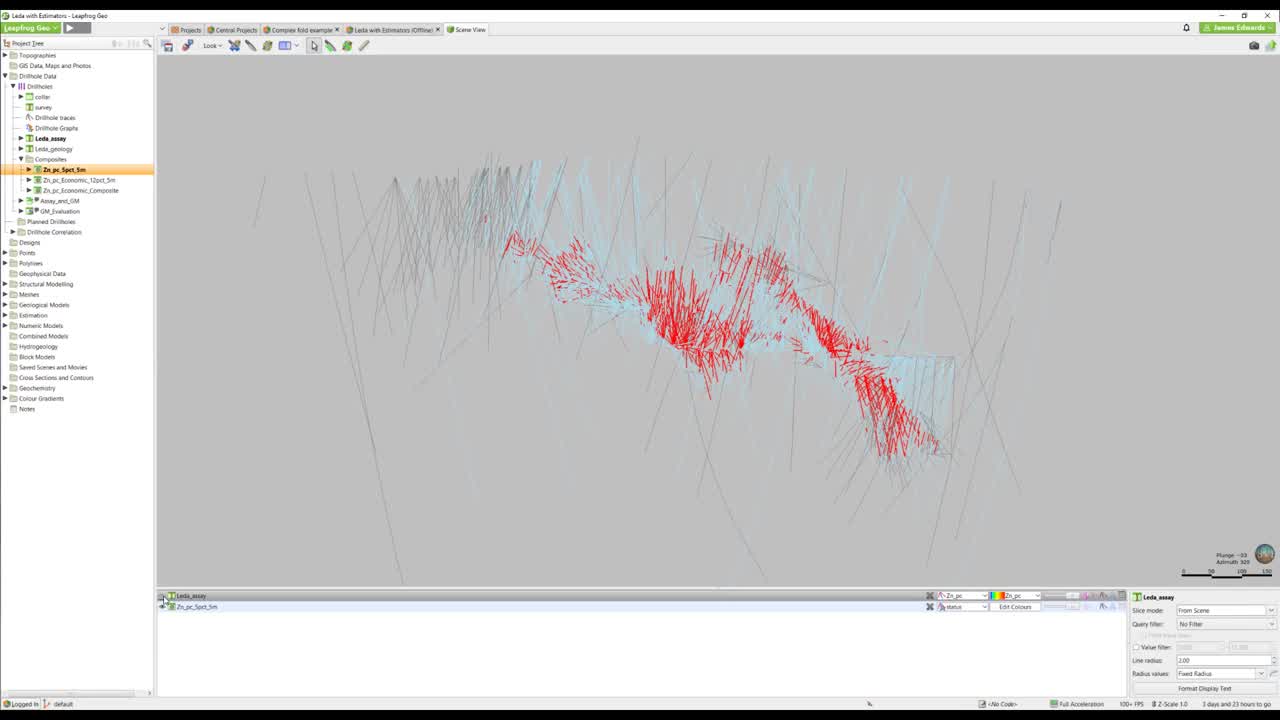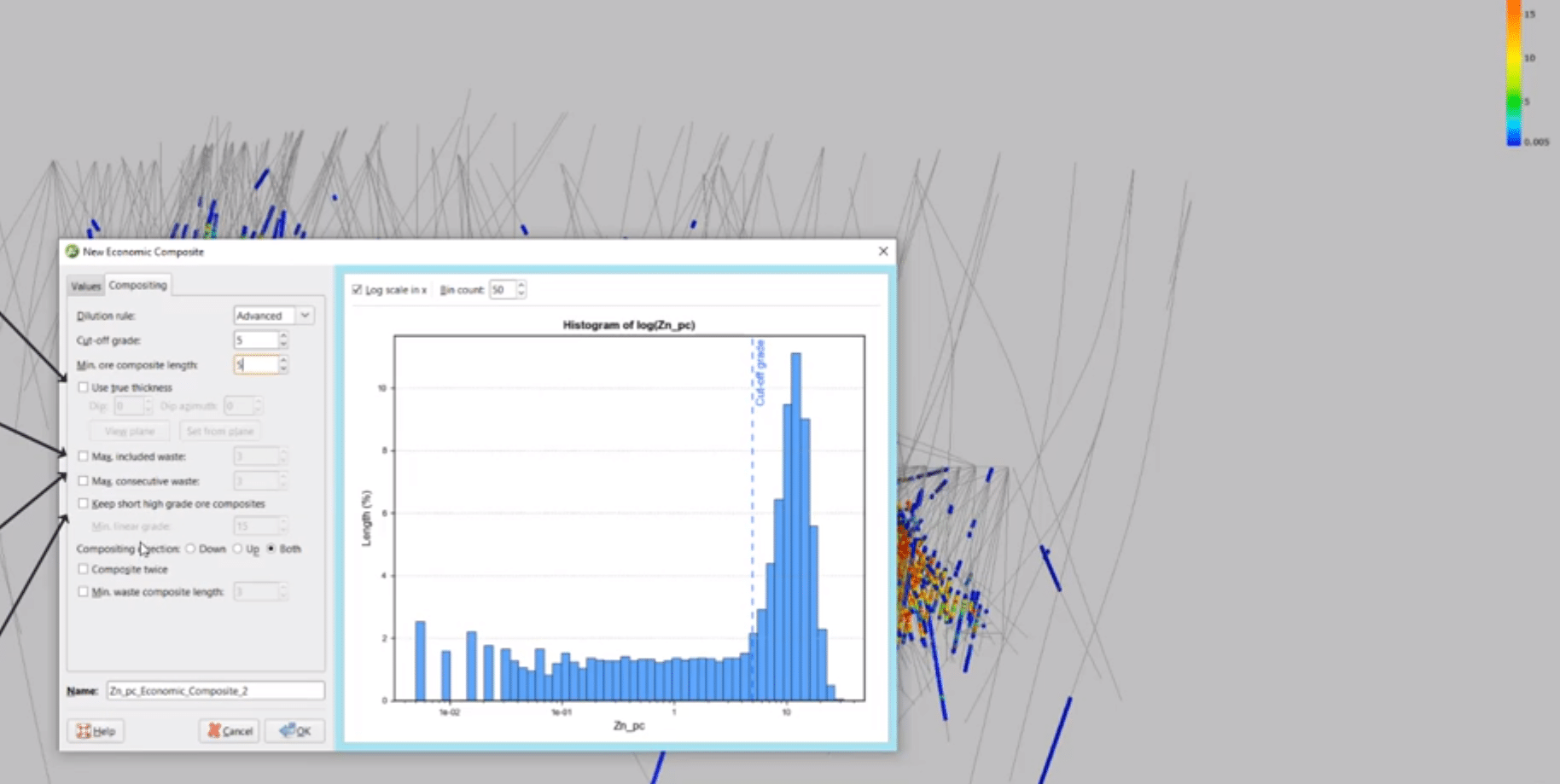In this video we will show how to apply an economic composite to a sample database.
Economic compositing classifies assay data into “ore” and “waste” categories, taking into account grade thresholds, mining dimensions and allowable internal dilution
Duration
9 min

See more on demand videos
VideosFind out more about Seequent's mining solution
Learn moreVideo Transcript
[00:00:07.400]
<v Narrator>Welcome to our bite-sized video</v>
[00:00:09.350]
on the economic compositing.
[00:00:11.780]
The short demonstration is designed to give you
[00:00:14.260]
an introduction to using the economic compositing tool.
[00:00:17.940]
For a detail review and guide,
[00:00:19.610]
we have a longer video available on our YouTube channel.
[00:00:23.830]
In Leapfrog, you have the option to composite drill holes.
[00:00:27.190]
Compositing is a process to reduce the variability
[00:00:29.770]
of sample sizes, that may exist in a database.
[00:00:34.230]
There are several reasons
[00:00:35.340]
why you may want to composite drill hole data,
[00:00:37.380]
and leapfrog provides different methods
[00:00:39.330]
to achieve the desired output.
[00:00:43.040]
For today’s video,
[00:00:43.873]
we are focusing on the economic composite tool.
[00:00:47.390]
The economic composite tool takes the raw assay data
[00:00:50.130]
and sets always rules based on run length grade
[00:00:53.180]
and internal dilution.
[00:00:56.160]
The output includes all waste categorical intervals,
[00:00:59.580]
as well as numeric composite intervals
[00:01:01.230]
based on a cutoff grade,
[00:01:02.690]
which can then be used to generate geological model volumes,
[00:01:05.700]
and used for statistical analysis and numeric modeling.
[00:01:10.690]
The aim is to create a reasonable mineralized envelope
[00:01:13.780]
from all intervals that have been generated
[00:01:15.550]
based on mine ability parameters,
[00:01:17.750]
in addition to a cutoff grade.
[00:01:20.930]
This is useful when geology is maybe poorly understood,
[00:01:23.880]
geology doesn’t control mineralization,
[00:01:26.470]
or when assay is the only information that is available.
[00:01:32.195]
So we’ll jump into leapfrog,
[00:01:33.550]
and we’ll start by having a look our assay data.
[00:01:39.290]
So here you can see one of our datasets,
[00:01:42.790]
where we’ve had a number of drill holes
[00:01:44.070]
intersecting mineralization.
[00:01:46.500]
In more advanced deposits,
[00:01:48.140]
you may know,
[00:01:48.973]
or want to evaluate
[00:01:49.890]
a number of mining in an economic parameters,
[00:01:51.770]
such as the impact of applying gray cutoffs
[00:01:54.330]
and minimum mining widths.
[00:01:57.440]
All compositing tools in leapfrog
[00:01:59.380]
can be found under the drill holes object,
[00:02:02.730]
in the composites folder.
[00:02:06.950]
Right click and will bring up the menu.
[00:02:08.710]
And then we can select the economic composite tool.
[00:02:12.970]
When you initially open the economic compositing tool,
[00:02:15.300]
there are a number of options available.
[00:02:17.800]
Firstly, you set the numeric value of interest.
[00:02:21.810]
In this case, we’re going to be looking today at zinc.
[00:02:25.090]
You can set rules for missing values.
[00:02:27.240]
You can either use a fixed value.
[00:02:29.670]
Sometimes things like half the detection limit,
[00:02:33.360]
or you can use an average of the enclosed intervals,
[00:02:35.500]
if your mineralization is more continuous.
[00:02:39.040]
In particularly nuggety deposits,
[00:02:41.610]
or ones with extreme outliers,
[00:02:42.970]
you can cap high grades as well.
[00:02:47.630]
Next, we have the compositing tab.
[00:02:50.340]
There are three composting types to choose from,
[00:02:53.610]
basic, advanced and advanced plus.
[00:02:58.330]
Basic uses a simple length weighted average,
[00:03:02.320]
and will tend to produce longer waste or composites.
[00:03:06.090]
The advanced and advanced plus
[00:03:09.510]
are generally more conservative,
[00:03:11.140]
in that they provide greater control
[00:03:13.040]
over waste dilution of ore.
[00:03:14.750]
For today’s exercise we’ll pick advanced.
[00:03:18.310]
For the cut off grade, the histogram can be used as a guide.
[00:03:23.140]
There’s an option to set a standard view or lock scale,
[00:03:28.800]
and you can also adjust the number of bins.
[00:03:32.780]
Depending on what you set your cut-off grade at
[00:03:35.340]
values greater than or equal to the cutoff grade
[00:03:37.390]
is considered ore and less than is considered waste.
[00:03:42.620]
For today’s analysis we will set the cutoff at five.
[00:03:47.800]
And for the minimum ore composite length,
[00:03:50.070]
we will set the value at five meters.
[00:03:54.800]
The minimum ore interval can be designed to meet
[00:03:56.760]
a predetermined mineable ore size
[00:03:58.710]
or other factors that you may need to consider.
[00:04:02.640]
Use true thickness setting can be applied when drilling
[00:04:05.380]
is a bleak to the major trend of mineralization,
[00:04:08.130]
which can result in some…
[00:04:09.570]
sample intervals becoming much longer than the true width
[00:04:13.830]
selecting this option requires composting algorithm.
[00:04:16.790]
To composite using true thickness,
[00:04:18.610]
measured perpendicular to a specified reference plane,
[00:04:21.900]
essentially weighting the value,
[00:04:23.410]
so as not to over-represent mineralized samples.
[00:04:27.640]
Max included waste is an optional threshold.
[00:04:30.230]
The constraints is the total length of waste
[00:04:31.960]
that can be accumulated within an ore composite.
[00:04:34.900]
Increasing this value will permit
[00:04:36.950]
greater dilution of ore with waste
[00:04:39.310]
before the candidate ore section will be rejected.
[00:04:43.220]
Max consecutive waste is an optional threshold for basic,
[00:04:46.950]
and advanced dilution rules,
[00:04:48.680]
but it is required for the advanced plus.
[00:04:51.630]
It constraints the length of the consecutive end force
[00:04:53.980]
classified as waste that can be considered
[00:04:56.340]
for addition to an old composite.
[00:05:00.620]
keep short high grade or composites is an option that allows
[00:05:04.070]
all composites less than the minimum length to be included.
[00:05:08.540]
This is provided at the minimum linear grade is exceeded.
[00:05:12.100]
Compositing direction,
[00:05:13.480]
just determines which way the algorithm runs
[00:05:16.780]
up or down the hole.
[00:05:19.180]
And when you use an advanced,
[00:05:20.080]
advanced plus, both is selected as default.
[00:05:24.420]
compositing twice,
[00:05:26.000]
will run the compositing process a second time
[00:05:28.130]
after the first pass,
[00:05:29.510]
which can sometimes help to smooth out and the results.
[00:05:34.540]
Once we’ve set a cut-off grade of 5%
[00:05:37.640]
and a minimum length of five,
[00:05:39.950]
I’m going to leave the other ones as default,
[00:05:43.150]
and we’ll just pick an appropriate name
[00:05:45.960]
for our composite table.
[00:05:54.680]
click okay and let this run.
[00:05:59.670]
Once this is processed,
[00:06:01.600]
we now have the new table in our composite folder.
[00:06:06.730]
If we double click to look at the table,
[00:06:08.130]
we can see it brings up an overview of the data available.
[00:06:14.040]
To quickly run through these,
[00:06:15.350]
status is the category, is defined as ore or waste
[00:06:18.950]
based on our parameters.
[00:06:21.270]
Using the same column gives you the weighted average grade
[00:06:24.550]
of that interval.
[00:06:26.440]
The true length is the linear length of that interval.
[00:06:30.980]
Linear grade is the average grade times by the true length.
[00:06:37.210]
The dilution true length,
[00:06:39.780]
is the total length of any diluting intervals.
[00:06:42.600]
i.e, intervals that fall below the cutoff we’ve specified.
[00:06:46.560]
Your dilution linear grade, is the weighted linear grade
[00:06:50.410]
below the cutoff material times by the length
[00:06:53.748]
and the percentage missing,
[00:06:56.220]
is the percentage of missing samples within the composite.
[00:07:02.610]
If we load, our composite table onto the scene,
[00:07:08.780]
we can turn off the assays, and have a look at the results.
[00:07:14.950]
So you can see we had the legend.
[00:07:19.350]
That the composting tool has gone through
[00:07:20.780]
and classified our drill holes
[00:07:22.410]
into waste in blue, and ore intervals in red.
[00:07:30.390]
If we turn off the waste,
[00:07:35.270]
we can start to get an idea of the trend,
[00:07:38.830]
and the direction of the mineralization.
[00:07:49.290]
To have a look at this in a bit more detail
[00:07:50.690]
what we’ll do is,
[00:07:51.523]
we’ll focus in on one particular drill hole.
[00:07:55.190]
If I click on my ore interval,
[00:07:58.260]
I get the same statistics that we looked at on the table.
[00:08:01.550]
So in this case,
[00:08:02.383]
I can see that my ore interval is 55.1 meters long
[00:08:06.120]
and average grade of 12.72%.
[00:08:10.340]
Within this ore interval, I have 2.5 meters of dilution,
[00:08:17.180]
and we can see that 2.5 meters is probably this
[00:08:21.550]
sample sits in here.
[00:08:24.310]
I can color this by the same discreet color map
[00:08:28.010]
to see what falls above and below.
[00:08:31.060]
We can then start to understand the impacts
[00:08:33.370]
of these decisions through numerical models
[00:08:35.470]
or use the category data to model domains.
[00:08:38.760]
For a reasonably complex topic.
[00:08:40.330]
This is a very brief overview.
[00:08:42.350]
As mentioned at the start of the video,
[00:08:43.840]
we have a more detailed discussion around the settings
[00:08:45.980]
and processes on our YouTube channel,
[00:08:47.810]
which I’d recommend you watch.
[00:08:49.010]
If this is something that may be of value to you.
[00:08:51.990]
Thanks very much for joining.





